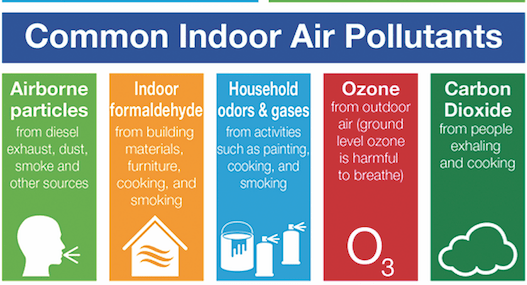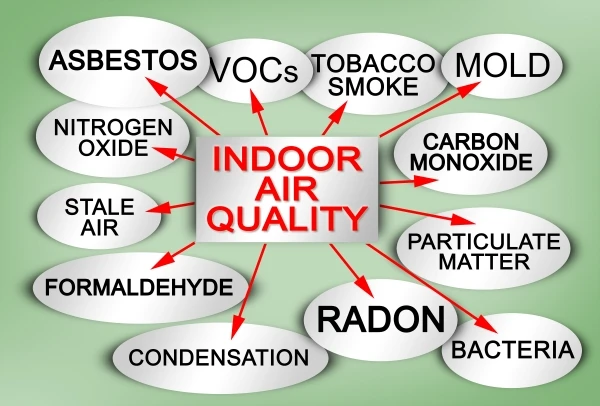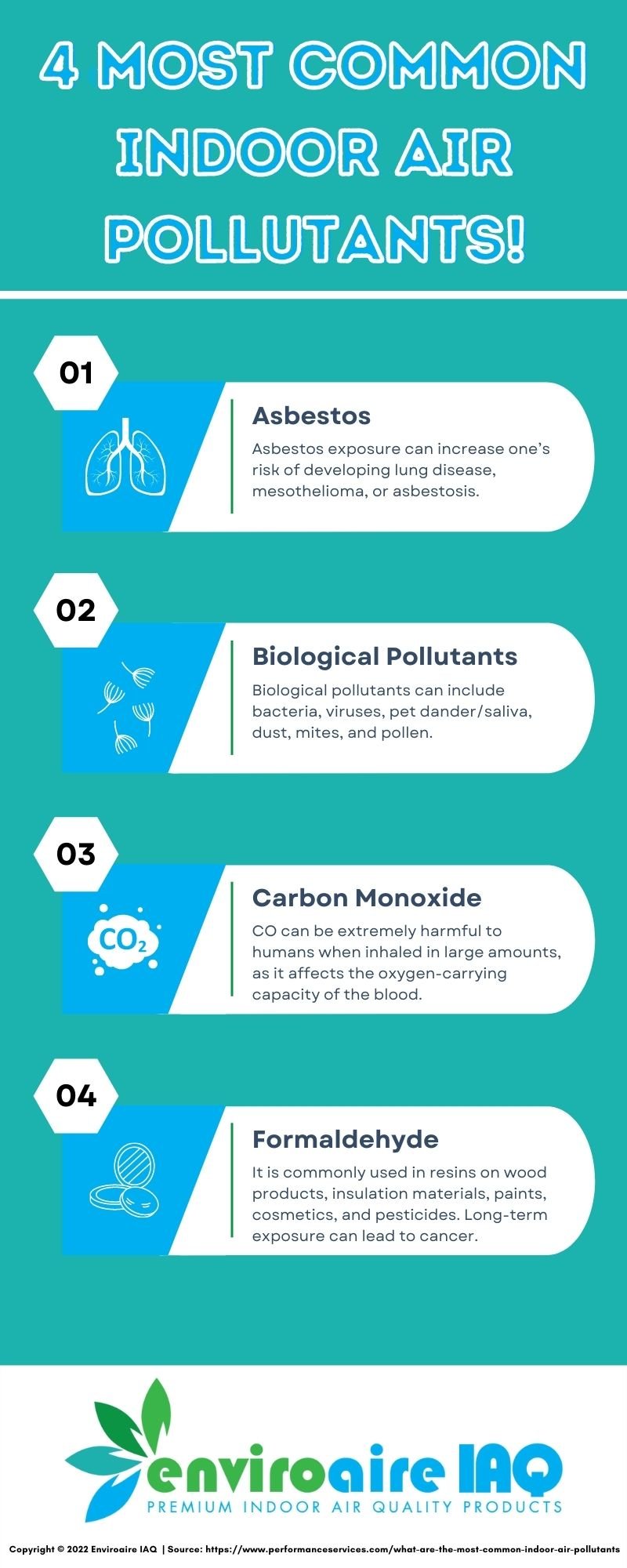Indoor air quality is crucial for our health. Many pollutants can make it worse.
Understanding indoor air pollutants is essential. They can affect our health and well-being. Pollutants come from many sources. Household items, building materials, and outdoor air can contribute. Poor air quality can cause allergies, asthma, and other respiratory problems. Knowing the common indoor air pollutants helps you take steps to reduce them.
This blog will explore the most common indoor air pollutants. You’ll learn how they enter your home and how to minimize their effects. Let’s dive into the world of indoor air pollutants and protect our health.
Introduction To Indoor Air Quality
Indoor air quality (IAQ) refers to the air quality within buildings and structures. It impacts the health and comfort of building occupants. Many people spend a large portion of their time indoors. Therefore, maintaining good indoor air quality is essential for health and well-being.
Importance Of Indoor Air Quality
Good indoor air quality is crucial for maintaining a healthy living environment. Poor air quality can lead to health issues and discomfort. It can affect children, the elderly, and those with existing health conditions more severely.
Several factors contribute to indoor air quality. These include ventilation, humidity, and the presence of pollutants. Ensuring proper ventilation helps to dilute indoor pollutants. This can significantly improve air quality.
Health Impacts Of Poor Air Quality
Exposure to poor indoor air quality can cause immediate and long-term health effects. Common symptoms include headaches, dizziness, and fatigue. Long-term exposure can lead to more serious conditions like respiratory diseases.
The following table lists some common indoor air pollutants and their health effects:
| Pollutant | Health Effects |
|---|---|
| Formaldehyde | Respiratory irritation, cancer risk |
| Mold | Allergic reactions, asthma |
| Carbon Monoxide | Headaches, dizziness, death |
| Volatile Organic Compounds (VOCs) | Eye, nose, and throat irritation |
It is important to identify and control indoor pollutants. This helps to reduce health risks and improve the quality of life. Regular cleaning, proper ventilation, and using air purifiers can help maintain good indoor air quality.
Household Dust And Particulate Matter
Indoor air quality is essential for a healthy home environment. Among the many pollutants, household dust and particulate matter are the most common. These tiny particles can affect your health in various ways. Understanding their sources and health risks can help you manage and reduce their presence in your home.
Sources Of Household Dust
Household dust comes from many sources. Here are the most common:
- Dead skin cells: Humans shed skin cells daily, contributing to dust.
- Pet dander: Pets shed tiny flakes of skin.
- Textile fibers: Clothing, carpets, and upholstery release fibers.
- Insect parts: Dead insects and their droppings add to dust.
- Outdoor particles: Dirt and pollen enter through windows and doors.
Health Risks Of Particulate Matter
Particulate matter (PM) includes tiny particles suspended in the air. These particles can be harmful when inhaled. Here are the primary health risks:
| Particulate Matter Size | Health Risks |
|---|---|
| PM10 | Can irritate eyes, nose, and throat. |
| PM2.5 | Can penetrate lungs and cause respiratory issues. |
| PM1 | Can enter the bloodstream and affect heart and brain. |
Exposure to particulate matter can trigger asthma attacks. It can also worsen existing lung diseases. Long-term exposure can lead to chronic respiratory conditions. Children and the elderly are particularly vulnerable.
Mold And Mildew
Mold and Mildew are common indoor air pollutants that thrive in damp conditions. Their presence in homes can lead to serious health issues and property damage. Understanding the causes of mold growth and its health effects is crucial for maintaining a healthy living environment.
Causes Of Mold Growth
Mold needs moisture to grow. It often appears in areas with water leaks or high humidity. Common causes of mold growth include:
- Leaks in roofs, windows, or pipes
- Poor ventilation in bathrooms and kitchens
- Flooding or water damage
- Condensation on cold surfaces
Reducing moisture is key to preventing mold growth. Regularly check and fix leaks, and use dehumidifiers in damp areas.
Health Effects Of Mold Exposure
Exposure to mold can cause various health problems, especially for sensitive individuals. Some common health effects include:
| Health Effect | Description |
|---|---|
| Allergic Reactions | Sneezing, runny nose, and itchy eyes |
| Respiratory Issues | Wheezing, coughing, and shortness of breath |
| Asthma Attacks | Can trigger and worsen asthma symptoms |
| Skin Irritation | Rashes and other skin problems |
To minimize health risks, keep indoor humidity low and clean moldy areas promptly. Always use protective gear when cleaning mold.
Volatile Organic Compounds (vocs)
Volatile Organic Compounds (VOCs) are dangerous chemicals found in many indoor environments. These compounds easily become vapors or gases, affecting air quality. Understanding their sources and effects can help you maintain a healthier home.
Common Sources Of Vocs
VOCs come from various household products and activities. Here are some common sources:
- Paints and Varnishes: Freshly painted walls often release VOCs.
- Cleaning Supplies: Many cleaners have chemicals that emit VOCs.
- Pesticides: Sprays used to kill pests can release harmful vapors.
- Building Materials: New carpets and pressed-wood products can off-gas VOCs.
- Personal Care Products: Hair sprays, perfumes, and deodorants often contain VOCs.
Health Consequences Of Voc Exposure
Exposure to VOCs can lead to a range of health issues. Here are some effects:
- Short-term Effects:
- Headaches
- Dizziness
- Eye, nose, and throat irritation
- Long-term Effects:
- Damage to liver, kidney, or central nervous system
- Increased risk of cancer
Monitoring and reducing VOC levels in your home can protect your health. Always use products with low or no VOCs and ensure proper ventilation.
Carbon Monoxide
Among the various indoor air pollutants, carbon monoxide (CO) is particularly dangerous. It’s a colorless, odorless gas that can be lethal. Understanding its sources and symptoms is crucial for safety.
Sources Of Carbon Monoxide
Carbon monoxide can come from several sources within your home. Here are the most common ones:
- Gas stoves
- Heaters
- Fireplaces
- Car exhausts from attached garages
- Portable generators
- Charcoal grills
These sources can release CO if not properly ventilated. Regular checks can prevent CO buildup.
Symptoms Of Co Poisoning
Carbon monoxide poisoning can be hard to detect. Here are some common symptoms:
- Headaches
- Dizziness
- Nausea
- Shortness of breath
- Confusion
- Loss of consciousness
Seek immediate medical help if these symptoms appear. CO poisoning can be fatal.
Radon Gas
Radon gas is an invisible, odorless, and tasteless radioactive gas. It seeps into homes and buildings, posing significant health risks. Understanding its origins and associated dangers is crucial for indoor air quality.
Origins Of Radon
Radon gas comes from the natural breakdown of uranium in soil, rock, and water. It enters buildings through cracks and gaps in floors and walls. Basements and ground-level rooms are more prone to radon infiltration. Poor ventilation can increase indoor radon levels.
Health Risks Associated With Radon
Radon exposure is the second leading cause of lung cancer after smoking. Long-term exposure increases the risk of developing lung cancer. Children and smokers are more vulnerable to radon-related health issues. It’s important to test homes for radon and take action if levels are high.
Pet Dander And Allergens
Pets bring joy to many homes. They also bring pet dander and allergens. These can be a major indoor air pollutant. Knowing the sources and managing them is key to a healthier home.
Sources Of Pet Dander
Pet dander is tiny, even microscopic. It comes from dead skin cells of animals. Cats and dogs are common sources. Birds and rodents also produce dander. It can cling to fur, feathers, and skin. These particles easily become airborne.
Once in the air, they settle on furniture, bedding, and carpets. Dander can stay in the air for long periods. Even homes without pets can have dander. It can be brought in on clothing or shoes.
Managing Allergens In The Home
Managing pet allergens can improve air quality. Here are some steps to consider:
- Keep pets out of bedrooms.
- Use air purifiers with HEPA filters.
- Wash pet bedding regularly.
- Vacuum carpets and furniture often.
- Groom pets regularly to reduce dander.
Regular cleaning helps reduce allergens. Use a vacuum with a HEPA filter. Clean floors, furniture, and pet areas. Wash hands after petting or grooming pets.
Consider using allergen-proof covers on mattresses and pillows. These can help keep dander from settling. Air purifiers are also effective. They can trap airborne dander and other allergens.
With these steps, you can reduce pet dander in your home. This makes the air cleaner and healthier for everyone.

Credit: www.teachengineering.org
Tobacco Smoke
Tobacco smoke is a major indoor air pollutant. It affects many people, even non-smokers. This section will explore the components of tobacco smoke and the health impacts of secondhand smoke.
Components Of Tobacco Smoke
Tobacco smoke contains over 7,000 chemicals. Many of these are harmful. Some are even toxic. Nicotine is the addictive substance in tobacco. It keeps people smoking. Tar is another component. It stains teeth and lungs. Carbon monoxide is also present. It reduces the oxygen in your blood. These are just a few of the harmful substances in tobacco smoke.
Health Impacts Of Secondhand Smoke
Secondhand smoke is also known as passive smoke. It affects non-smokers who are near smokers. Breathing in secondhand smoke is dangerous. It can cause lung cancer. It can also lead to heart disease. Children exposed to secondhand smoke may develop asthma. Babies can suffer from sudden infant death syndrome (SIDS). Pregnant women exposed to secondhand smoke may have low birth weight babies. These health impacts are serious. Avoiding secondhand smoke can protect your health and the health of your loved ones.
Improving Indoor Air Quality
Indoor air quality plays a crucial role in our health. Many common pollutants can affect the air we breathe inside our homes. These pollutants include dust, mold, pet dander, and chemicals from cleaning products.
Improving indoor air quality is essential for a healthier living environment. There are several strategies to help reduce these pollutants. Let’s explore some effective methods to improve indoor air quality.
Ventilation Strategies
Proper ventilation is key to improving indoor air quality. Open windows regularly to allow fresh air inside. Use exhaust fans in kitchens and bathrooms to remove moisture and odors.
Ensure your home has adequate airflow. This helps dilute indoor pollutants and reduces their concentration. Consider installing a whole-house ventilation system for better air circulation.
Air Purification Methods
Air purifiers can significantly improve indoor air quality. Choose a purifier with a HEPA filter to capture small particles like dust and pollen. Place air purifiers in commonly used rooms for maximum effect.
Houseplants can also help clean the air. Plants like spider plants and snake plants absorb toxins and release oxygen. Regularly clean and maintain your air purifiers to ensure they work efficiently.

Credit: www.greenbuildermedia.com

Credit: www.aireserv.com
Frequently Asked Questions
What Are The Common Indoor Air Pollutants?
Common indoor air pollutants include mold, dust mites, pet dander, and tobacco smoke. These can cause allergies and respiratory problems.
How Does Mold Affect Indoor Air Quality?
Mold releases spores into the air, which can cause respiratory issues and allergies. It thrives in damp, humid environments.
Why Is Tobacco Smoke Harmful Indoors?
Tobacco smoke contains harmful chemicals and toxins. These can cause respiratory diseases, heart problems, and cancer over time.
Can Pet Dander Impact Indoor Air Quality?
Yes, pet dander can trigger allergies and asthma. It consists of tiny, even microscopic, flecks of skin shed by cats, dogs, rodents, birds, and other animals with fur or feathers.
Conclusion
Indoor air pollutants can seriously impact your health. Regularly check and clean your home. Use air purifiers and ventilate rooms often. Avoid smoking indoors and reduce use of strong chemicals. Plants can help filter the air. Healthy indoor air means a healthier life.
Stay aware and take steps to improve your air quality. Protect your loved ones by keeping your indoor air clean.
Rakib Sarwar is a Registered Pharmacist and a reputed health and wellness blogger. He has a great interest in Air purifiers.
